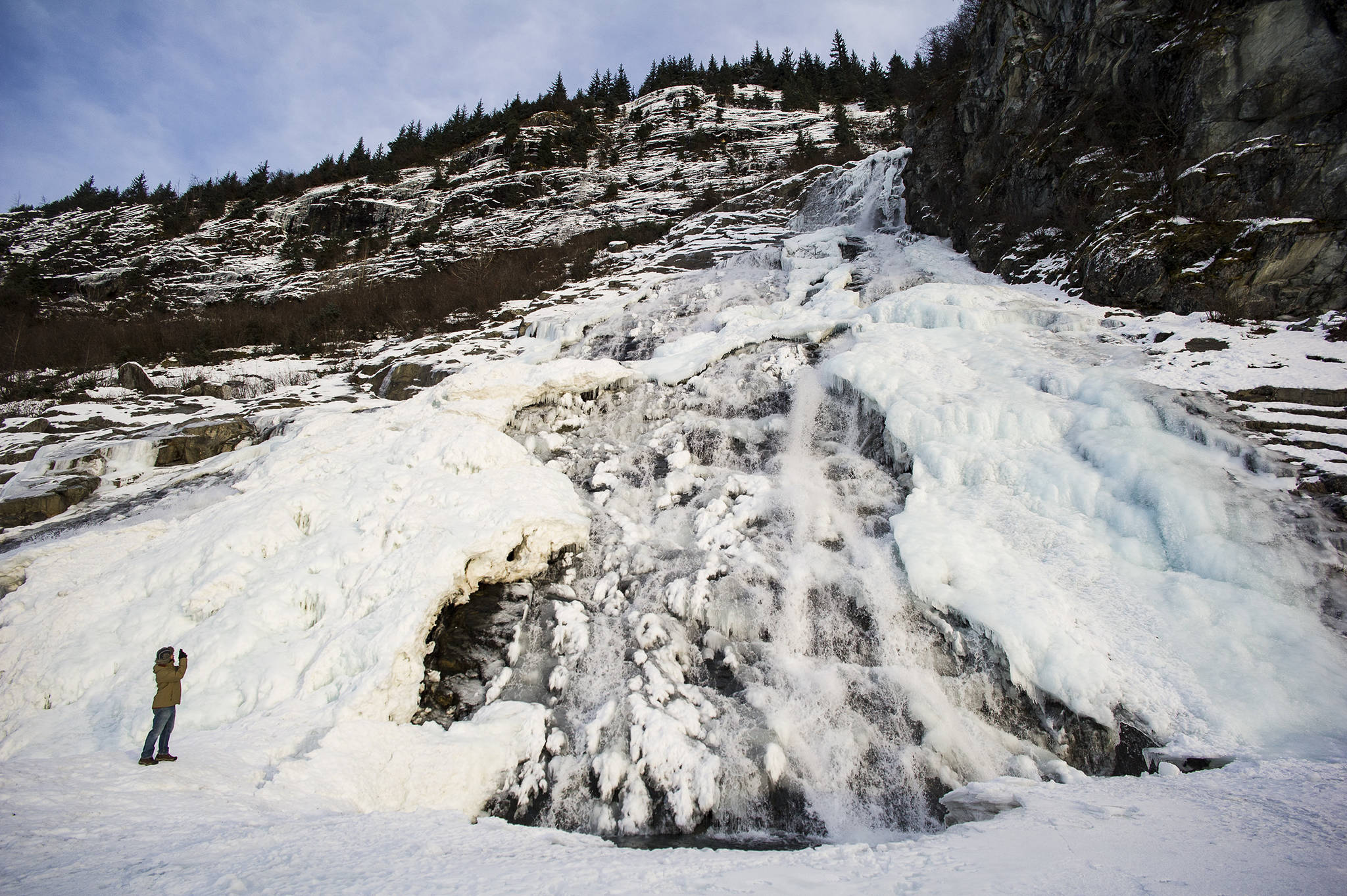Sometime in mid-January, after a nice cold snap, the temperatures soared into the fifties; even near the glacier it was in the balmy forties. Near the visitor center, sidewalks and trails were slick with ice. A friend and I were headed for a walk on the beach, and we were glad we’d brought our ice cleats.
As we walked down the ramp from the first parking lot, we saw that the pond on the right had a very low water level — the little beaver dam that helps to form that pond was gone. Unfortunately, the lower water levels exposed an area along one shoreline where sockeye spawn. That exposure probably meant that eggs in those redds were killed when temperatures plummeted into the single digits for days at a time, earlier in the winter. Although lots of water was coming down Steep Creek, it didn’t add much to this pond but went into the lake by another outlet.
Once we reached the beach, walking was less slippery but very crunchy. Needle ice had created towers and chasms and a mini Grand Canyon as the thin needles grew up into cold air, perhaps fusing together as they grew. The low brush on the sand flats was liberally decorated with wind-blown gull feathers, both long flight feathers and fluffy body feathers, as if there had been a molting party on the beach.
A large, much-battered log had arrived on the beach. It had been standing in the forest not too long ago: it still had small colonies of moss and lichen, as well as scars from bark-chewing porcupines. We guessed that this old hemlock had travelled from Nugget Valley and down over Nugget Falls before arriving here. A similar log, probably part of the same tree, had landed not far away, along with a smaller tree with smashed roots. We don’t often see big timbers washed up on this side of the lake. The heavy winter weather, with winds and rains, may have brought the tree into the creek and over the falls; a temporary high water level had stranded the broken trunk on the beach.
Among some bushes at the edge of the beach, we found a dead female northern shrike. The keel on the sternum (breastbone) was very pronounced, indicating that it had little stored fat and may have been starving. However, there was some blood on the face, and when we skinned the head, we found hemorrhage in the skull; there was also some internal bleeding in the abdominal cavity. This bird probably hit a window somewhere, got a concussion, but somehow managed to fly away before it gave up the ghost. We speculated that perhaps it had been chasing another bird (to eat it!) so vigorously that it failed to notice a window — this is something other predatory birds sometimes do too.
Shrikes come to us sometimes on migration or in winter, and we see them on the sandy flats near the glacier or out on the edges of the wetlands. They favor semi-open, shrubby habitats, often sitting on top of a bush while looking for tempting prey. They are predators, capturing insects and birds, often on the wing, as well as small mammals. They sometimes capture birds as large or larger than themselves, such as robins and jays. They often capture birds by grabbing them with their feet, but other prey are more often captured with the bill. The upper bill has a sharp hook at the end and two small “teeth” on the edge, not far behind the hook. Hook and teeth no doubt help in dispatching a captured prey animal: they typically kill vertebrates by biting them through the neck, while insects are generally just crunched up. Sometimes called “butcher birds” (in fact their genus name, Lanius, means butcher in Latin), shrikes often impale dead prey on thorns or barbed wire, or in branch forks, to be eaten on the spot or later.
Another interesting find was a beaver-cut branch of feltleaf willow on which the catkins had lost their bud-covers and expanded into nice, fluffy willows. January is normally too early for this willow to flower, even though it is the earliest one to do so in the spring. We inspected several trees of this species along the lakeshore and found just a few fat buds and two partially open catkins. The branch we found was well ahead of those that were still on their trees, perhaps as a trauma response to being cut. Plants can respond to damage by releasing enzymes and proteins that produce changes in undamaged parts of the plant; in some cases there is an accelerated development of reproductive organs.
• Mary F. Willson is a retired professor of ecology. “On The Trails” appears every Friday. Her essays can be found online at onthetrailsjuneau.wordpress.com.

